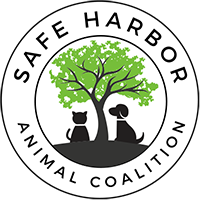
06 Sep Be Prepared: Pet Disaster Planning
Pet disaster planning is something that everyone with pets must do these days. No matter where you live, natural disasters can happen without warning. Tornadoes, floods, forest fires … you name it, we’ve seen it, and have helped animals that are affected by those extreme situations. The best thing to do for the animals that you care for is have a plan in place in case a natural disaster does strike.
Remember: Community cats are resourceful. The outdoors is their home, so they know how to deal with weather. Animals often can sense when bad weather is coming and move to higher ground and safe places instinctually. However, there are still things you can do both ahead of time and during emergencies to help outdoor cats and your own pets. We’re here to help you get that together!
Prepare
- Have descriptions of your pets and the community cats you care for, along with photos. If you need to look for displaced cats in shelters or other rescue areas, this will help accurately identify them. Make sure all pet tags and animal microchips have up-to-date information.
- Have a back-up caregiver who is responsible for the community cats in your absence and network with other community cat caregivers in your area to set up a ‘buddy system’ to create a safety net of care for the cats. You may be able to find other cat caregivers in your area through Alley Cat Allies’ Feral Friends Network.
- Make an emergency contact card for your pets and community cat colonies in case you are not immediately available. Include all contact information for your substitute caregiver. Carry this card in your wallet and your car, give copies to your backup caregiver, and post it somewhere visible in your home like on the refrigerator.
- Make a list of local shelters and their contact information. You will need this information in case you need their help or resources.
- Keep an emergency supply kit on hand and know where to find it quickly.
When Harsh Weather is Forecasted or Predicted
- If appropriate, turn all openings for community cat shelters and feeding stations away from the storm surge or toward higher ground. If possible, move them to slightly higher, protected ground nearby.
- Fill multiple food and water bowls in case you have to evacuate and can’t return immediately.
- In general, don’t wait for evacuation orders to come before you leave the area.
If You Do Need to Evacuate
- Bring your pets with you, but do not try to trap and contain unsocialized (or feral) community cats.
- Have a safe place to go ahead of time. Evacuation and Red Cross shelters do not usually accept pets. Make a list of pet-friendly hotels outside the evacuation zone. La Quinta and Motel 6 are two consistently pet-friendly chains. Check with family and friends. And lastly, have a list of boarding facilities that may be available during an emergency.
- Bring your emergency supply kits, as well as additional provisions to provide the feral colony, upon your return.
After the Disaster Has Passed and It Is Safe To Return
- Begin cleaning up the colony area to remove any potential hazards for the cats. Check feeding stations and outdoor shelters for damage.
- Look for the cats in your colony. If any are missing, immediately:
- Determine which agencies, if any, are on the ground in your area assisting animals. Contact those organizations directly and provide a description of the cats you are missing. Determine how you can claim these cats if they are found.
- Contact your local shelters. Ask if they are trapping cats in your area, and determine how long they will hold feral cats. Shelters may be experiencing a high volume of calls and influx of animals. For this reason, we advise that caregivers go to the shelters in person to find missing cats. Determine from shelter staff how you can claim your cats.
- Don’t panic if the cats aren’t waiting when you get back. Cats can hide for days after severe weather before returning to their colonies.
Emergency Supply Kits
We encourage pet owners to have a basic disaster supply kit ready at all times. The following items should be kept in an easily accessible and easy-to-carry backpack or duffel bag in case you need to evacuate quickly. Disaster kit basics for pets include:
- Pet first-aid kit
- Supply of prescription medications for pets. Always remember to rotate these out of your kit and keep track of expiration dates so you are not carrying around useless or bad medication.
- Veterinary and microchip ID records for both pet and community cats.
- Pet food (3-7 days worth; be sure to rotate these out of your kit as needed) and dishes (collapsible are good).
- Litter box and litter.
- Leash and collar.
- Crate or carrier; pillow case other item in case you need to quickly grab your pet to leave.
- Blankets or towels.
- Photos of pets and cats in colonies in case they need to be identified.
- Bottled water (7 day supply per person and pet).
- Your kit for the people in your family, which should include: flashlight and extra batteries; credit card and cash; copies of personal identification; a portable, solar- or battery-powered radio or television and extra batteries; an extra set of car keys; matches in a waterproof container; duct tape; extra clothing and shoes; extra medication and copies of insurance information; permanent marker; and an all-in-one tool like a Swiss army knife or Leatherman®.
Helping Others with Animals
If you plan on responding to a disaster as a volunteer, we recommend transporting the following items that are always in demand during emergency animal rescue:
- Bottled water
- Dry and canned pet food and can openers
- Dog crates and carriers
- Humane cat traps
- Old towels, sheets, and blankets
- Leashes and collars
- Litter boxes
- Heavy gloves and protective clothing
- Lanterns and flashlights with batteries
- Portable generators
- Medical supplies:
- bandages
- sterile gauze pads
- absorbent dressing
- antiseptic
- flea and tick repellants
- instant cold packs
- latex gloves
We hope these tips help you, your family, and your pets to stay safe in emergencies!
Resource: alleycat.org

